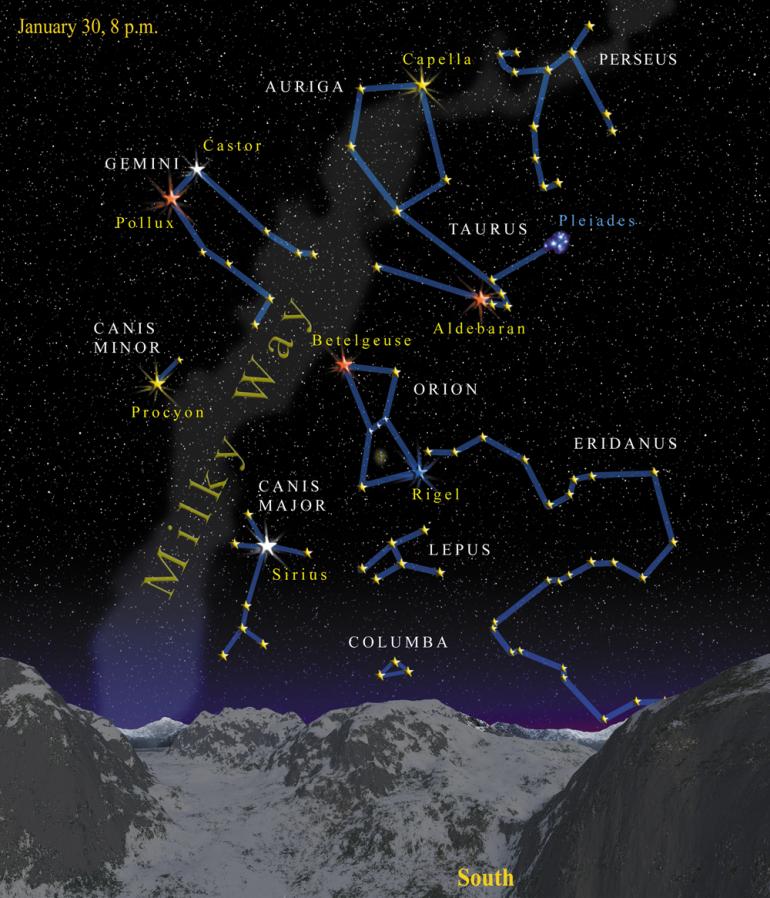The Winter Charioteer
Montana’s horse-and-buggy days are long over, the buckboards and freight wagons of frontier days have been replaced by today’s 4x4 pickup for hauling modern Westerners and their gear. Winter sleighs have morphed into snowmobiles, tractors instead of equine teams pull plows, and the transition from horse to horsepower is all but complete when it comes to putting in a day’s work.
But the sky still preserves old traditions, and on frosty winter nights, we can find an homage to horse-pulled transportation in the prominent form of Auriga, the celestial charioteer.
Look high, above the familiar figure of Orion and his belt, to find the pentagon-shaped Auriga balanced on the horn-tip of Taurus the bull (with which it shares a star), drifting overhead on winter evenings. The house shape forms the frame of the driver himself, the uppermost star marking his head as he sits facing us in his vehicle. The bottom two stars mark his feet, and the stars right and left his shoulders. The brightest star of the pattern is the one marking his left shoulder—although it more accurately marks the nanny goat draped over it. This is Capella, the Goat Star, and the mother of the three kids indicated by the little triangle of stars directly below it.
Just why Auriga is giving his pet goats a ride is not clear, but Capella is sometimes viewed as Amalthea—the goat who nourished the god Zeus during his exile as an infant on the island of Crete during the days when his father Cronus had a tendency to eat his children to prevent them from supplanting him as head deity (which happened anyway). In any case, charioteers—when they weren’t trundling into battle bristling with spears or bows and arrows—were the keepers of the king’s horses and minders of the livestock raised for the royal table, it is said, and so an agrarian connection is not entirely out of place. They weren’t always playing Ben Hur.
There is, however, a famous Greek story of chariot races, unrequited love, treachery, and intrigue that would make excellent fodder for a cinematic soap opera. It seems that in ancient times, King Oenomaus of Elis, winner of chariot races (thanks to a fine team of horses and his expert driver Myrtilos), had a daughter named Hippodamia whom he was loathe to give away in marriage. A pesky oracle had declared that the king’s son-in-law would do him in, and so he plotted not to have one.
Thus, as each suitor for Hippodamia’s hand came forth to claim it, Oenomaus challenged him to a chariot race to the death, which the outmatched swain inevitably lost. The king had notched a dozen grisly victories when who should stop by but handsome Pelops ready to try his hand. But this time, things were different. Pelops caught Hippodamia’s eye, she liked what she saw, and she decided it was time to fix the race and get married. So the sly Hippodamia approached the chariot driver Myrtilos, took advantage of his secret love for her, and got him to remove the wheel pegs from her father’s chariot. When the king and Myrtilos thundered off the next day against Pelops, Myrtilos knew to hang on—and Oenomaus didn’t. When the chariot collapsed at full speed, the king was thrown to his death and Hippodamia was free to wed.
Myrtilos, the hapless charioteer, expected that his payoff would be the hand of Hippodamia. Alas, not so. The duped Myrtilos was pushed off a cliff into the sea by Pelops, and Pelops and Hippodamia ruled the Greek peninsula for some years to come. Myrtilos’ small measure of revenge was to be immortalized as Auriga, who now gets to race (slowly) across the winter sky every frigid evening.
A happier story suggests that Auriga is another charioteer—Erichthonius, the lame son of the lame god Hephaestus, who invented the horse-driven chariot to get around better. Zeus, who found the invention clever, placed him in the sky as a result.
Again, the goats are a bit of an add-on, but the yellowish Capella is striking, the pattern is easy to find, and Auriga makes a fine addition to the retinue of brightly-starred characters wheeling westward across the winter sky. So give a tip of the hat to fellow traveler Auriga as you make your way together on those cold, clear nights!
Jim Manning is head of the Office of Public Outreach at the Space Telescope Institute in Baltimore, Maryland, but maintains Montana roots just "Outside Bozeman."












